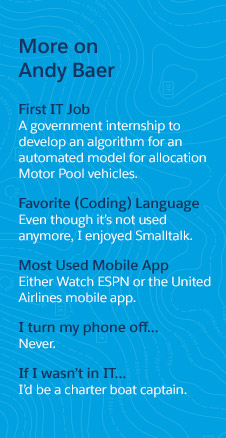
Get your FREE 30-day trial.
Please complete all fields.
Andy Baer is a 30-year veteran of the IT sector, including more than five years spent as the CIO of Comcast Cable. There he was responsible for transforming the communication company’s IT strategy across all of its customer care, front line employee support, and corporate systems, by introducing cutting-edge solutions to support both growth and customer experience improvements. For this edition of “IT Trailblazers,” Baer, now SVP for the Global Communications and Media Industry Group at Salesforce, shares his advice for adapting in the rapidly changing services industry and why he believes so-called IT projects are never just about IT.
 1. How has the services CIO’s role changed in recent years?
1. How has the services CIO’s role changed in recent years?
The CIO now needs to be more vocal and involved in what the art of the possible is when it comes to how technology can be used to innovate. Previously, the CIO's responsibility was running infrastructure, and in some cases, running utilities on top of that infrastructure, but not necessarily being innovative from a business perspective. Today, while the CIO still has to run infrastructure, to the extent it still exists in a company, they are also being asked to become part of the business team that is helping to define how technology can be used effectively, to both maintain great customer relationships and for new products. The services business is enabled by technology and every product must have an aligned omni-channel acquisition and support strategy implemented by the CIO’s team.
2. What’s the best way to embrace this evolution?
Partner across the business and technology organizations to develop innovative and effortless omni-channel customer experience capabilities, while relentlessly eliminating those legacy capabilities that are no longer relevant to your customers. For example, if you take the majority of your payments electronically, why do you still have this huge amount of money for producing bills, when a simple online customer statement is all the customer wants?
3. How should CIOs go about introducing new technology that makes an impact?
First, remember that introducing technology is not the end goal – it’s introducing new business capabilities that will drive customer acquisition, retention, and customer experience. Technology is only a part – and actually the minority part of implementing a successful business program. Business process change is both harder and more important. If you're using cloud, for example, to re-platform a function that is already running a legacy technology, simply for the purpose of re-platforming it, you're bound to be disappointed. The only way it makes sense is if you are using the technology project as a way to reinvent the business process to achieve a different objective, such as an improved customer or employee experience.
4. Does accomplishing this successfully come down to looping in the Business?
Many CIOs have been on the receiving end of business projects, while not viewed as a true business partner. As a result, they simply wait to be asked to do projects, which creates a less-than-ideal relationship between the two. Today, more and more of the business organizations, whether they be the product-line organizations or the CMOs or even the CFOs, are going to have more partners and people that are technologically savvy. The CIO needs to be an equal partner in business innovation and be willing to take ideas to the business leaders and be part of the team that's bouncing those ideas around.
5. Why do you say there is no such thing as an “IT project”?
There are only business projects. I never spent a dollar of a company's money that was just for IT. It was only because it was in specific response to a business need. Projects are business projects. So if you can't figure out how to culturally create an environment where you and your business partners feel equally accountable and responsible, then you're going to have a much higher failure rate. If you can figure out how to create an environment where your business partners feel equally accountable, then they're going to do whatever is necessary to make the project succeed.

6. The word “innovative” is thrown around a lot. How should CIOs approach it?
Look for opportunities to create startup-like environments within your own IT organization, where you can move at a more rapid pace by disrupting yourself. Run them separately from, and in parallel to, your more traditional legacy organization. Lookfor those individuals -- employees or contractors -- that are disruptive and want to think like they're disruptive, because if you don't take it upon yourself to act that way, the business organization will end up disrupting you by going around you. And unfortunately, they'll do it in a way that will cause you more work in the long term and will perpetuate the challenges you have in keeping up with the business organization. Remember, in today’s business environment, it’s not the biggest companies that survive, but the most agile and fastest to innovate.
7. What’s one of the biggest lessons you learned as CIO?
One thing that is really hard to do in corporate America -- and I wouldn't say I did it as well as I liked to, but I would hope that at least I moved the ball downfield and learned a bit about it -- is creating a culture that isn't afraid to take risks and fail. Because it's only through the right kinds of experimentation and failure that you really move the organization forward. In big companies where there's such a stigma against failure, people just tend to not take any risk. If you create an organization that takes no risks at all, you get an organization that gets no reward either. Be relentless about building an organization that can take risks.